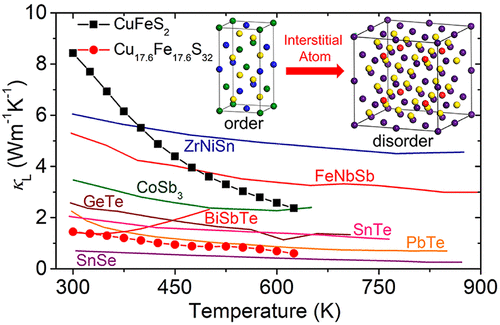当前位置:
X-MOL 学术
›
J. Am. Chem. Soc.
›
论文详情
Our official English website, www.x-mol.net, welcomes your
feedback! (Note: you will need to create a separate account there.)
Origin of intrinsically low thermal conductivity in talnakhite Cu17.6Fe17.6S32 thermoelectric material: correlations between lattice dynamics and thermal transport
Journal of the American Chemical Society ( IF 14.4 ) Pub Date : 2019-06-16 , DOI: 10.1021/jacs.9b05072 Hongyao Xie 1 , Xianli Su 1 , Xiaomi Zhang , Shiqiang Hao , Trevor P. Bailey 2 , Constantinos C. Stoumpos , Alexios P. Douvalis 3 , Xiaobing Hu , Christopher Wolverton , Vinayak P. Dravid , Ctirad Uher 2 , Xinfeng Tang 1 , Mercouri G. Kanatzidis
Journal of the American Chemical Society ( IF 14.4 ) Pub Date : 2019-06-16 , DOI: 10.1021/jacs.9b05072 Hongyao Xie 1 , Xianli Su 1 , Xiaomi Zhang , Shiqiang Hao , Trevor P. Bailey 2 , Constantinos C. Stoumpos , Alexios P. Douvalis 3 , Xiaobing Hu , Christopher Wolverton , Vinayak P. Dravid , Ctirad Uher 2 , Xinfeng Tang 1 , Mercouri G. Kanatzidis
Affiliation

|
Understanding the nature of phonon transport in solids and the underlying mechanism linking lattice dynamics and thermal conductivity is important in many fields, including the development of efficient thermoelectric materials where a low lattice thermal conductivity is required. Herein, we choose the pair of synthetic chalcopyrite CuFeS2 and talnakhite Cu17.6Fe17.6S32 compounds, which possess the same elements and very similar crystal structures but very different phonon transport, as contrasting examples to study the influence of lattice dynamics, and chemical bonding on the thermal transport properties. Chemically, talnakhite derives from chalcopyrite by inserting extra Cu and Fe atoms in the chalcopyrite lattice. The CuFeS2 compound has a lattice thermal conductivity of 2.37 Wm-1K-1 at 625 K, while Cu17.6Fe17.6S32 features Cu/Fe disorder and possesses an extremely low lattice thermal conductivity of merely 0.6 Wm-1K-1 at 625 K, approaching the amorphous limit min. Low temperature heat capacity measurements and phonon calculations point to a large anharmonicity and low Debye temperature in Cu17.6Fe17.6S32, originating from weaker chemical bonds. Moreover, Mössbauer spectroscopy suggests that the state of Fe atoms in Cu17.6Fe17.6S32 is in partially disordered structure which induces the enhanced alloy scattering. All the above peculiar features which are absent in CuFeS2, are contributing to an extremely low lattice thermal conductivity of the Cu17.6Fe17.6S32 compound.
中文翻译:

talnakhite Cu17.6Fe17.6S32 热电材料固有低热导率的起源:晶格动力学与热传输之间的相关性
了解固体中声子传输的性质以及将晶格动力学和热导率联系起来的潜在机制在许多领域都很重要,包括开发需要低晶格热导率的高效热电材料。在此,我们选择具有相同元素和非常相似的晶体结构但声子传输非常不同的合成黄铜矿 CuFeS2 和 talnakhite Cu17.6Fe17.6S32 化合物作为对比示例来研究晶格动力学和化学键对热传输特性。从化学上讲,talnakhite 是通过在黄铜矿晶格中插入额外的 Cu 和 Fe 原子而衍生自黄铜矿的。CuFeS2 化合物在 625 K 时的晶格热导率为 2.37 Wm-1K-1,而 Cu17.6Fe17。6S32 具有 Cu/Fe 无序特征,在 625 K 时具有极低的晶格热导率,仅为 0.6 Wm-1K-1,接近非晶极限min。低温热容测量和声子计算表明 Cu17.6Fe17.6S32 中存在较大的非谐性和较低的德拜温度,这源于较弱的化学键。此外,穆斯堡尔光谱表明,Cu17.6Fe17.6S32 中的 Fe 原子处于部分无序结构,这会导致合金散射增强。CuFeS2 中不存在的所有上述特性导致 Cu17.6Fe17.6S32 化合物的晶格热导率极低。低温热容测量和声子计算表明 Cu17.6Fe17.6S32 中存在较大的非谐性和较低的德拜温度,这源于较弱的化学键。此外,穆斯堡尔光谱表明,Cu17.6Fe17.6S32 中的 Fe 原子处于部分无序结构,这会导致合金散射增强。CuFeS2 中不存在的所有上述特性导致 Cu17.6Fe17.6S32 化合物的晶格热导率极低。低温热容测量和声子计算表明 Cu17.6Fe17.6S32 中存在较大的非谐性和较低的德拜温度,这源于较弱的化学键。此外,穆斯堡尔光谱表明,Cu17.6Fe17.6S32 中的 Fe 原子处于部分无序结构,这会导致合金散射增强。CuFeS2 中不存在的所有上述特性导致 Cu17.6Fe17.6S32 化合物的晶格热导率极低。
更新日期:2019-06-16
中文翻译:

talnakhite Cu17.6Fe17.6S32 热电材料固有低热导率的起源:晶格动力学与热传输之间的相关性
了解固体中声子传输的性质以及将晶格动力学和热导率联系起来的潜在机制在许多领域都很重要,包括开发需要低晶格热导率的高效热电材料。在此,我们选择具有相同元素和非常相似的晶体结构但声子传输非常不同的合成黄铜矿 CuFeS2 和 talnakhite Cu17.6Fe17.6S32 化合物作为对比示例来研究晶格动力学和化学键对热传输特性。从化学上讲,talnakhite 是通过在黄铜矿晶格中插入额外的 Cu 和 Fe 原子而衍生自黄铜矿的。CuFeS2 化合物在 625 K 时的晶格热导率为 2.37 Wm-1K-1,而 Cu17.6Fe17。6S32 具有 Cu/Fe 无序特征,在 625 K 时具有极低的晶格热导率,仅为 0.6 Wm-1K-1,接近非晶极限min。低温热容测量和声子计算表明 Cu17.6Fe17.6S32 中存在较大的非谐性和较低的德拜温度,这源于较弱的化学键。此外,穆斯堡尔光谱表明,Cu17.6Fe17.6S32 中的 Fe 原子处于部分无序结构,这会导致合金散射增强。CuFeS2 中不存在的所有上述特性导致 Cu17.6Fe17.6S32 化合物的晶格热导率极低。低温热容测量和声子计算表明 Cu17.6Fe17.6S32 中存在较大的非谐性和较低的德拜温度,这源于较弱的化学键。此外,穆斯堡尔光谱表明,Cu17.6Fe17.6S32 中的 Fe 原子处于部分无序结构,这会导致合金散射增强。CuFeS2 中不存在的所有上述特性导致 Cu17.6Fe17.6S32 化合物的晶格热导率极低。低温热容测量和声子计算表明 Cu17.6Fe17.6S32 中存在较大的非谐性和较低的德拜温度,这源于较弱的化学键。此外,穆斯堡尔光谱表明,Cu17.6Fe17.6S32 中的 Fe 原子处于部分无序结构,这会导致合金散射增强。CuFeS2 中不存在的所有上述特性导致 Cu17.6Fe17.6S32 化合物的晶格热导率极低。













































 京公网安备 11010802027423号
京公网安备 11010802027423号